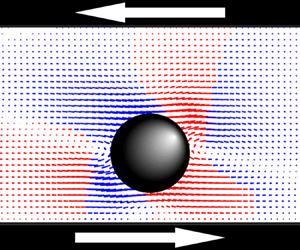Article contents
Dynamics of a sphere in inertial shear flow between parallel walls
Published online by Cambridge University Press: 29 March 2021
Abstract

The motion of a rigid sphere in ambient simple shear flow of a Newtonian fluid between infinite parallel walls is calculated via the lattice Boltzmann method for various particle Reynolds numbers,  ${\textit {Re}}_p=Ga^2/\nu$, where
${\textit {Re}}_p=Ga^2/\nu$, where  $G$ is the velocity gradient of the shear;
$G$ is the velocity gradient of the shear;  $a$ is the particle radius; and
$a$ is the particle radius; and  $\nu$ is the kinematic viscosity of the fluid. For a neutrally buoyant sphere, there exists a critical
$\nu$ is the kinematic viscosity of the fluid. For a neutrally buoyant sphere, there exists a critical  ${\textit {Re}}_p$ below which the hydrodynamic lift force has a single zero crossing, driving the particle to an equilibrium position at the centre of the channel. Above the critical
${\textit {Re}}_p$ below which the hydrodynamic lift force has a single zero crossing, driving the particle to an equilibrium position at the centre of the channel. Above the critical  ${\textit {Re}}_p$, the equilibrium position of the sphere undergoes a supercritical pitchfork bifurcation; inertial lift creates three equilibrium positions: an unstable equilibrium position at the centre and two stable equilibria equidistant from the centre. The critical
${\textit {Re}}_p$, the equilibrium position of the sphere undergoes a supercritical pitchfork bifurcation; inertial lift creates three equilibrium positions: an unstable equilibrium position at the centre and two stable equilibria equidistant from the centre. The critical  ${\textit {Re}}_p$ occurs below the transition to unsteady flow, and increases with increasing particle confinement ratio,
${\textit {Re}}_p$ occurs below the transition to unsteady flow, and increases with increasing particle confinement ratio,  $\kappa =a/H$, where
$\kappa =a/H$, where  $H$ is the channel height. The equilibrium position of a non-neutrally buoyant sphere shifts toward a confining wall of the channel, in a manner that is dependent on the orientation, i.e. horizontal or vertical, of the channel. In both channel alignments, the gravitational force breaks the symmetry of the particle dynamics about the centreline of the channel, resulting in an imperfect bifurcation above a critical
$H$ is the channel height. The equilibrium position of a non-neutrally buoyant sphere shifts toward a confining wall of the channel, in a manner that is dependent on the orientation, i.e. horizontal or vertical, of the channel. In both channel alignments, the gravitational force breaks the symmetry of the particle dynamics about the centreline of the channel, resulting in an imperfect bifurcation above a critical  ${\textit {Re}}_p$. However, a sufficiently strong gravitational force will break the bifurcation and produce a single off-centre equilibrium position. We finally consider a neutrally buoyant sphere under the cessation or reversal of shear flow.
${\textit {Re}}_p$. However, a sufficiently strong gravitational force will break the bifurcation and produce a single off-centre equilibrium position. We finally consider a neutrally buoyant sphere under the cessation or reversal of shear flow.
Information
- Type
- JFM Papers
- Information
- Copyright
- © The Author(s), 2021. Published by Cambridge University Press
References
REFERENCES
- 12
- Cited by


